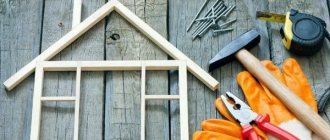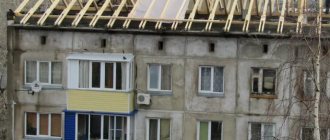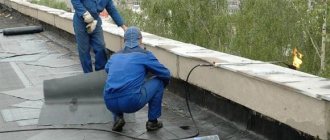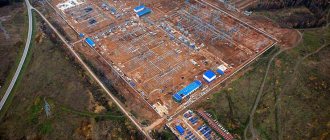Causes of roof leaks
The roofing system must be in perfect condition, only in this case can you be sure of its reliability. Regular roof inspections will help avoid trouble. Even the smallest flaws in your roof can cause big problems later on.
What can cause a roof leak? There are quite a few reasons:
- Poor selection of roofing materials.
- Mistakes by builders in the placement of roof layers.
- Errors in the construction of the sheathing, in the calculation of the pitch of the rafters.
- Lack of ventilation in the ridge part of the roof, improper functioning of vents, weather vanes in the eaves area.
- Technological violations in the arrangement of the roof.
- Improper creation of a water drainage system.
- Use of low-quality construction and fastening materials.
It should be noted that leaks can signal errors in the design and construction of not only the roof, but also the entire building. For example, a roof structure may become skewed if the builders and designers did not take into account the peculiarities of foundation movements.
Deformations in the building structure that occur due to errors in design or construction can cause roof leaks
What mistakes are most often made in roof installation?
Inexperienced teams of roofers and people making their own roofs at their dachas often make mistakes that are not given much importance. This is wrong because after some time, this becomes the main reason for repairs. These include:
- cracks and gaps in thermal insulation;
- leaky fit of the vapor barrier layer or its installation as a layer “in reverse”;
- lack of ventilation – imperfect ventilation system;
- lathing, packed unevenly ;
- the connection is poorly made.
These seemingly insignificant errors cannot be allowed. Therefore, you should trust the installation of the roof to people who strictly monitor all this.
The time of year when repair and installation work is carried out is of great importance - it is a warm, but not hot period. Ideally - autumn or spring. All work must be carried out in dry weather. This will ensure even drying. This applies to paintwork and insulation.
Leak classification
Depending on the time of occurrence, all leaks can be divided into three types:
- "rainy";
- "snowy";
- insulating.
The first option is often detected during precipitation. During rains or some time after them, a wet spot forms on the ceiling or water actually drips. If the roof has a flat structure, then such a flaw is very easy to find. It is located directly below the leak. When the roof is pitched, it is much more difficult to localize the leak.
The interior of the room is completely damaged due to a roof leak
The second case of leakage is associated with the melting of snow and ice. It is during this period that accumulations of melted snow and ice formations can be seen in the interior of the room. Most often, drain funnels, valleys, gutters, etc. are affected.
Leakage can also result from a wet insulating layer of the roof. This occurs in hot summer weather. Excess condensation forms when there is a large temperature difference between the outside of the building and in front of the insulation. The vapor barrier membrane does not cope with the task of retaining excess moisture, this leads to leakage. Very often such troubles occur due to improper waterproofing.
Types of roof repairs
There is regulatory and technical documentation regulating the inspection, determination of the type of leak and subsequent repair of the roof:
- Construction norms and rules SNiP II-26–76.
- GOST standards.
- Technical requirements.
Even the most cursory inspection of such a roof will reveal a large number of defects.
Any roof repair work is preceded by a thorough inspection of the roof, rafter structure, and thermal insulation layer. When problem areas are identified, they are highlighted with chalk or paint. It is worth inspecting the roof both from the outside and from the attic, carefully studying the condition of the roof and identifying damaged areas. It is advisable to carry out the inspection during the day, and determine the location of leaks during rain.
Emergency roof repair
This type of work is carried out in emergency situations. The purpose of the repair is to urgently eliminate the integrity of the roof covering. Severe leaks can cause irreparable damage to the underlying premises, thermal insulation structure and supporting structures.
A quick response to a roof leak will save building residents from serious repairs to the premises
The estimate for the maintenance of the building must contain expense items for this case.
Current roof repairs
Current repairs are carried out twice a year (spring and autumn) and are prescribed in the planned activities of service organizations.
A patch placed in the area of the leak will increase the lifespan of the roof.
The spring-autumn inspection of roofs should record the readiness of the roof for uninterrupted operation and determine the types of repair work if necessary.
Current repairs are carried out to ensure that the building serves for a long time and with high quality. When planning ongoing repairs, the following must be taken into account:
- climatic conditions of building operation;
- design features;
- mode of use of the building;
- technical condition of the roof.
The organization that operates the building pays for ongoing roof repair work.
Major roof repairs
Carrying out major repairs involves implementing a whole range of measures aimed at eliminating any roof faults. They remove worn-out structures and replace them with new, more modern ones in terms of efficiency and durability. All this is done if the roof and rafters can no longer be used safely. The wear of the load-bearing elements of the roof must be at least fifty percent.
If the roof is very worn, it is necessary to replace the entire roof covering.
Problems that are solved during major roof repairs:
- improving roof performance;
- extending the service life of the building;
- increasing energy efficiency;
- change in appearance.
The time boundaries for the start and end of repair work are determined in accordance with regulatory documents adopted by industry management bodies.
Estimated and contract prices are taken into account when determining the cost of major repairs.
The difference between a major overhaul and a current one
The natural process of roof wear requires periodic repairs of the roofing and insulating coating, rafter system and gutters.
Current repairs ensure the serviceability of the roof after the start of its operation and before subsequent major repairs.
The speed of ongoing repairs is determined by the degree of wear of the roofing elements. It is stipulated by the “Resolution of the State Construction Committee of the Russian Federation of September 27, 2003 N170,” which sets out the requirements for the supervision and maintenance of roofs.
During routine repairs on a metal roof, damaged parts are replaced with new ones
Major repairs involve the complete replacement of worn-out roofing pie, partial replacement of wooden structures, repair of prefabricated reinforced concrete floors and gutters. At the same time, ventilation shafts and parapets are restored and the roof covering is securely attached to them.
To increase the service life of the roof until the next major repair, outdated materials are replaced with modern ones: with less need for intermediate repairs.
Table: main differences between major and current repairs
| Events | Types of repairs | |
| capital | current | |
| Frequency | 10–50 years (depending on roof type) | 3–5 years |
| Type of work | dismantling worn elements and replacing them with new ones over the entire surface | spot (local) repair |
| Conditions | if more than 40% of the roof is damaged | for minor damage |
At the same time, fire retardant and antiseptic treatment of wooden rafter structures is carried out at least once every ten years.
The cost and timing of major repairs significantly exceed the costs of partial repairs. Upon completion of the overhaul, a documented warranty is issued, which indicates the service life of the repaired roof.
Dismantling an old roof is a lengthy process, but it allows you to completely renew the covering, replacing it with a better and more modern one.
According to the Housing Code of the Russian Federation, clause 154, contributions for major repairs in multi-apartment buildings are included in the structure of monthly payments for residential premises. In a number of regions there are subsidies for major repairs of housing stock. Therefore, approval of repair work is carried out by the management company, whose engineering specialists conduct technical supervision and accept the work performed.
For more information about the procedure when applying for roof repairs in an apartment building, read our article - The roof has “gone”: who should repair the roof of an apartment building.
New roof repair technologies
Modern innovative technologies make it possible to repair roofs using the latest techniques. Liquid roof spraying is an effective technique that has a number of significant advantages:
- Carrying out repairs without removing the old roofing.
- Maximum protection against the adverse effects of sunlight.
- High adhesion (similar to welding).
- Highest level of elasticity.
- Short hardening time for the material.
- Low flammability.
- Environmental Safety.
- Durability (warranty period - 20 years).
- Resistance to microorganisms and rodents.
- Immunity to corrosion and aggressive environments.
Modern technologies facilitate and speed up the process of arranging and repairing a roof.
There are three types of liquid spraying most often used in roof repairs.
Table: types of liquid spraying
| Waterproofing basis | Features and Applications |
| Rigid foam (PPU, foam) | It is used on roofs of various designs (circle, semicircle, made of corrugated materials), taking into account the angle of inclination is optional. Well isolates any manifestations of moisture, protects the roofing from mechanical damage. |
| Two-component rubber | High adhesive ability, suitable for roofs with complex relief structures, does not leave seams. Low level of flammability. Does not have an unpleasant odor. |
| Polymer mastic of bituminous nature | An ideal monolithic coating for bases made of different materials and configurations. Does not require additional preparation (heating). Quite a cheap method. Rich color range of materials used. |
Application of liquid spraying is carried out in several layers, their number depends on the selected type of soft roof, as well as on the main tasks of construction and on the loads on the roof.
Video: spraying liquid rubber on the roof
How to choose the right company
You need to take time to choose a company that is worth trusting, so as not to waste a lot of time on this, you can use this site, which contains trusted construction companies that are ready to carry out roof repairs at your dacha thoroughly and efficiently.
Preparing the roof for repair - removing the top layer Source teammountain.org
Repair of different types of roofing
Roof renovation work may vary slightly depending on the type of material used to waterproof the roof.
Roll coating
One of the most common causes of roll roofing wear is moisture seeping under the roofing. Under the influence of high temperatures, water heats up and turns into a vapor state, which leads to the formation of swollen and cracked areas in the rolled roofing. A lot of such problem areas can form, and this causes extensive rupture of the rolled roofing.
The defect can be eliminated using patches. The effectiveness of their use largely depends on the quality of the work performed.
Roll roof repair process:
- Cleaning from debris and powder. This must be done especially carefully at the site of damage.
- Opening the area of damaged coating. In this case, it is necessary to lift all layers of the roof and remove the old mastic.
Opening and cleaning the damaged area must be carried out with special care - Inspection and detection of traces of leakage.
- Drying the insulating layer.
- Cementing detected holes, priming the repaired area.
- Applying a patch with the same number of layers that were in the worn coating.
The patch is installed on the damaged area, pre-treated with bitumen mastic - Treating the area with the patch with molten bitumen mastic.
The patch should be placed 10–15 cm under the edges of the old “carpet”. Similar actions are repeated when bubbles form on the rolled roofing. Having discovered a swelling, it is cut crosswise with a sharp knife. Then they act according to the scheme described above.
Mastic for roofing felt repair is prepared from hot molten bitumen with filling (small sawdust, chalk chips, flour, asbestos). From eight kilograms of bitumen and one and a half kilograms of filler, 10 kg of mastic is obtained. After the resulting mixture boils, used engine oil (a little) is poured into it.
Mastic is a flammable liquid, so you need to work with it in compliance with safety rules. Special clothing and shoes, a reliable and durable container for heating the mixture, a ladle for pouring - always with a long handle, safety glasses - all this is mandatory when working with mastic.
Video: how to fix a hole in the roof
Metal coating
A metal roof can be given a “second life” by patching, removing cracks, painting, and replacing damaged areas.
Patches are placed on straight planes or in areas of ridges. The metal sheet for patches is taken with allowances of several centimeters to cover the worn area of the roof. The patch is connected to the old coating by welding.
Small holes (30-200 mm) can be closed using not metal, but pieces of dense fabric - tarpaulin, burlap, pre-treated with oil paint (leaved in paint for 5-7 days). “Gluing” occurs using paint.
If the flaws in the roof are less than 30 mm, then they are simply covered with molten bitumen mixture or red lead. After installation, all patches are painted with compounds that are resistant to precipitation.
Caulking problem areas improves the condition of a metal roof
If the metal roof is worn out by more than 50%, you will have to replace the old sheets of metal with new ones.
Video: metal roof repair
Slate
The most common damage to slate material is cracks.
A roof with large cracks requires urgent repair of the defect.
You can deal with these defects yourself by covering them with bitumen resin, a mixture of drying oil and chalk, and sealant.
To eliminate large area defects, patches made of asbestos cement sheets are used. The hole in the slate is treated with a sealant mixture and covered with a patch cut with small allowances. Some repairmen use a special self-adhesive tape with high waterproofing properties.
Sealing tape effectively eliminates minor defects
Major repair work is carried out in case of significant damage to the slate roof, replacing sheets with holes with new slate.
Often, a slate roof covering becomes overgrown with moss. To avoid such a nuisance, treat the damaged areas with a grinder or a metal brush, removing the moss. Then paint with a primer mixture of the desired color in one or two layers.
If moss is found on the roof, remove it as quickly as possible and treat the damaged area with a primer mixture
Video: repairing old slate
Corrugated sheet
Repair of a corrugated roof is carried out depending on the size of the hole. Small, barely noticeable damage can be eliminated using ordinary self-tapping screws in the color of the roof. The only condition is that they must have rubber gaskets.
Large holes will take more work to fix. For this you can use:
- Sealants (silicone, polyurethane, thiokol, acrylic).
- Bitumen mastics.
- Sealing tapes.
- Special purpose putties.
Each of these materials has its own pros and cons; the choice depends on the defect, the purpose of the building and material capabilities.
Silicone sealant is considered universal; it does not require mixing, since it contains only one component. This material is highly adhesive, elastic, and resistant to temperature changes. The latter characteristic is especially relevant for corrugated roofing, which reacts sharply to temperature changes.
Polyurethane sealant is very easy to use (it is very easy to foam a hole), but it is “afraid” of ultraviolet rays and quickly deteriorates in the sun, so it should be used in places where there is no direct exposure to sunlight.
Thiokol sealants are applicable only for the repair of individual roof elements, most often for seams and adjacent parts. This is due to their vulnerability to climate change.
Acrylic sealant is an environmentally friendly material; it can be used to eliminate any roof defects, especially from the inside.
A new product on the Russian market in the field of roof repair - waterproofing tape - is also suitable for roofs made of corrugated sheets. This material is made of a 1.5 mm thick bitumen layer, covered on the outside with a reinforced aluminum film. During repairs, the internal protective film is removed and the tape is glued to the desired location.
Modern material makes it possible to quickly and efficiently eliminate small roofing defects
The polymer-bitumen base allows the use of putty for high-quality repairs of corrugated roofing. Sealing surfaces and finishing are tasks that such waterproofing easily copes with.
In case of major damage to the roof, entire sheets of corrugated sheeting will have to be replaced.
Video: eliminating roof leaks from corrugated sheets
Ruberoid
Roofing felt coatings should be regularly coated with heated bitumen mastic. Peeling of roofing material can be patched up in this simple way: apply mastic to the roof surface using a brush with a long handle, moving from the ridge part down. Sprinkle sand on top to improve adhesion and protect the bitumen roof from the destructive effects of ultraviolet radiation.
A patch is applied to the areas of swelling or cracks in the roofing material, after first cleaning and cutting the repair area. For gluing, mastic mass is used.
To ensure a long service life of the roof, it is necessary to coat the seams very carefully
Video: roofing felt roof repair
How to complain about poor quality work?
First of all, you should delve into the agreement with the management company in order to know for sure whether the management took upon itself those functions that it copes with poorly. In any case, routine roof repairs are clearly the prerogative of the management company.
If the work was performed in violation of building codes or of poor quality, then you should write a complaint to one of the authorities:
- housing inspection;
- Rospotrebnadzor;
- the prosecutor's office;
- court;
- Fund for Assistance to Housing and Communal Services Reform.
Calls will not bring any practical benefit; you need to make a complaint in writing . The main emphasis should be on the fact that low-quality services were provided at the personal expense of the owners, and you should not state something unfounded; specific facts should be indicated, supported, if possible, by documents. You can find out how to correctly write and submit a complaint to have your roof repaired here.
It is advisable to involve a disinterested specialist so that he can check the compliance of the actual volumes of work performed with the estimate; this is where the additions most often lie. The complaint must be sent by registered mail , leaving one copy for control.
You should not simultaneously address your complaints to all authorities at once; the judicial authorities should occupy the last place in this sequential chain, as the most extreme measure. The management company is responsible for the use of residents’ funds, and it is the management company that should begin to unravel the tangle of claims.
Repair of various types of roofs
The specifics of eliminating roof defects also depend on other roof parameters: configuration, color saturation, etc. Flat structures do not cause any particular difficulties during repairs.
Repair of pitched roofs
When repairing a pitched roof (single, gable, hip, attic), you should take into account the fact that moisture leaves this structure well by gravity. Therefore, you should not make too large allowances on the patches. You can save some material on overlaps.
With a roof slope of ten degrees or more, all materials are secured using special equipment. For roofs laid at an angle of less than 10°, you can use the ballast method (sprinkling with any suitable material). If strong winds often blow in the area where the building is located, then it is best to repair the roof using glue.
Seams on a pitched roof are welded or repaired using chemical compounds. If large areas of a pitched roof are being repaired, it is advisable to carry out work from the ridge to the eaves.
Translucent roof repair
The roof, which is made of translucent material, is one of the most difficult architectural structures (especially in terms of repairs).
Translucent roof covering has a number of advantages, but is very problematic to repair
The difficulty of operating a translucent roof is especially evident in winter, when snow accumulates on the roof and areas of icing may occur. The usual mechanical way of dealing with these difficulties is not suitable. The slightest scratches can affect the appearance of the structure and its performance characteristics.
Plastic is usually installed by professionals, so it is also better to entrust the repair of such a roof to experts in their field. Most often, the repair of a translucent roof consists of a complete replacement of a double-glazed window or panel.
Elimination of leaks in built-up roofs
Roofs installed using fused technology are repaired using patches. Polymer-bitumen membranes are also used to create melting seams.
In case of extensive damage to the roof during repairs, special work is also carried out to replace the screed.
According to Appendix 7 of Gosstroy Resolution No. 170 of September 27, 2003:
Appendix No. 7 (recommended)
LIST OF WORK RELATED TO CURRENT REPAIRS
1. Foundations
Elimination of local deformations, strengthening, restoration of damaged areas of foundations, ventilation ducts, blind areas and entrances to basements.
2. Walls and facades
Sealing of joints, sealing and restoration of architectural elements; changing sections of wooden wall cladding, repairing and painting facades.
3. Floors
Partial change of individual elements; sealing seams and cracks; strengthening and coloring.
4. Roofs
- Strengthening the elements of a wooden rafter system, antiseptic and anti-perforation;
- troubleshooting steel, asbestos-cement and other roofs, replacing drainpipes;
- repair of waterproofing, insulation and ventilation.
5. Window and door fillings
Replacement and restoration of individual elements (devices) and fillings.
6. Apartment partitions
Strengthening, changing, sealing individual areas.
7. Stairs, balconies, porches (umbrellas-visors) above the entrances to the entrances, basements, above the balconies of the upper floors
Restoration or replacement of individual sections and elements.
8. Floors
Replacement and restoration of individual sections.
9. Stoves and hearths
Troubleshooting work.
10. Interior decoration
Restoration of the finishing of walls, ceilings, floors in separate sections in entrances, technical rooms, and other general building auxiliary rooms and service apartments.
11. Central heating
Installation, replacement and restoration of the functionality of individual elements and parts of elements of internal central heating systems, including house boiler rooms.
12. Water supply and sewerage, hot water supply
Installation, replacement and restoration of functionality of individual elements and parts of internal water supply and sewerage systems, hot water supply, including pumping units in residential buildings.
13. Power supply and electrical devices
Installation, replacement and restoration of operability of the building's electrical supply, with the exception of intra-apartment devices and appliances, except for electric stoves.
14. Ventilation
Replacing and restoring the functionality of the in-house ventilation system, including the fans themselves and their electric drives.
15. Garbage chutes
Restoring the functionality of ventilation and flushing devices, waste collection valve covers and gate devices.
16. Special common house technical devices
Replacement and restoration of elements and parts of elements of special technical devices, carried out by specialized enterprises under a contract agreement with the owner (the body authorized by him) or with an organization servicing the housing stock, according to regulations established by manufacturers or relevant industry ministries (departments) and agreed upon state supervisory authorities organs.
17. External landscaping
Repair and restoration of destroyed sections of sidewalks, driveways, paths, blind areas of fences and equipment for sports, utility and recreation areas, platforms and sheds for waste containers.
Roof repair tools
To perform roofing work, you need to prepare a whole set of tools and materials:
- Gas-burner.
- A special stick for rolling out rolls.
- A broom or broom to clean worn areas of the roof.
- A spatula or trowel for smoothing out overlaps and applying putty.
- A sharp knife for cutting roofing material.
- Tin scissors for cutting out patches.
- Ax for clearing several layers of roofing structure.
- Container for melting mastic.
- A brush with a long handle for applying liquid compounds.
Gas-burner
Using a gas burner, you can melt the mastic and also dry the roofing material used to the desired temperature.
Modern gas burners are equipped with special functions for adjusting operating modes. This allows you to save gas consumption during forced downtime or in the intervals between laying layers of roofing.
A gas burner helps speed up the roof repair process
For the manufacture of gas burners, materials resistant to high temperatures are used. The long handle is another significant advantage of modern burners.
The restriction on the use of a gas burner is a temperature below minus 15 degrees. In more severe frost conditions, it is necessary to use burners with liquid fuel.
Compliance with safety rules when using a gas burner is a prerequisite for high-quality and efficient work:
- Use special clothing and special shoes.
- Check the equipment for serviceability of all components (tightness of cylinders, integrity of hoses).
- Do not light the burner while standing directly opposite it (only from the side!).
- Monitor possible overheating of deposited materials.
Who should pay for repairs
Residents who organize roof repairs for an apartment building have a choice. They can do this at their own expense, or they can take funds from another source.
The roof is a common property (like technical floors and the attic), and accordingly all residents are responsible for it.
According to current legislation, everyone who lives in the house is required to pay for repairs equally and on time. The amount that residents must pay depends on how much space they occupy.
Since everyone is equally responsible for what is happening in the house, the decision regarding the work must be made at a meeting by voting. An official statement is drawn up in which residents put their signatures.
Important! More than half should support the initiative to carry out the work.






